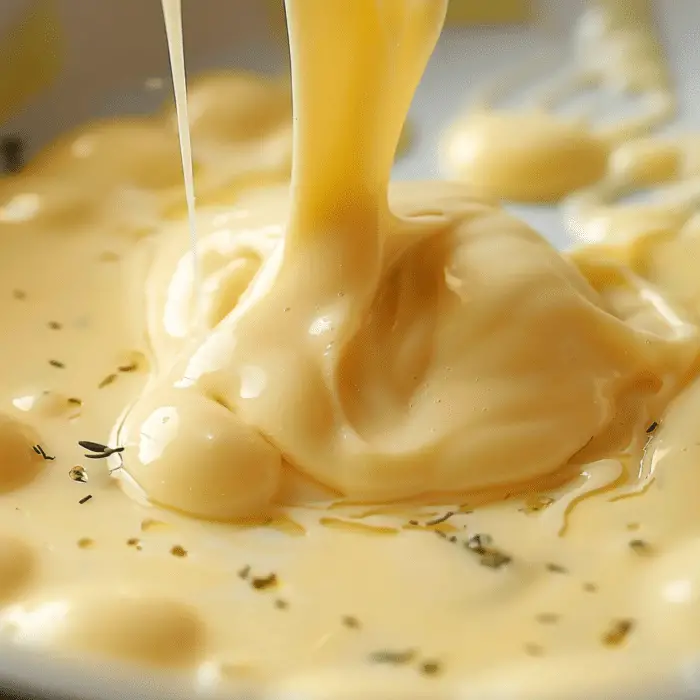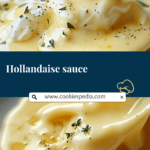Hollandaise sauce is a rich, buttery, and tangy sauce that adds a luxurious touch to a variety of dishes. Known for its smooth texture and bright, flavorful kick from lemon juice, it’s a key component of eggs Benedict but also pairs beautifully with grilled fish, steamed vegetables, and more. Making Hollandaise sauce from scratch may seem intimidating, but with a few simple ingredients and steps, you’ll have this velvety sauce ready to elevate your meals in no time

Ingredients
To prepare this creamy Hollandaise sauce, gather the following ingredients:
- 3 large egg yolks
- 1 tablespoon water
- 1 tablespoon lemon juice
- 1/2 cup unsalted butter, melted
- Salt and pepper to taste
- Optional: a pinch of cayenne pepper or a dash of hot sauce for added flavor
Instructions
- Whisk Together Egg Yolks, Water, and Lemon Juice
In a heatproof bowl, whisk the egg yolks, water, and lemon juice until the mixture is well combined and smooth. This will be the base of your Hollandaise sauce. - Set Up a Double Boiler
Next, place the bowl over a pot of barely simmering water. Be sure that the bowl does not touch the water. The steam from the water will gently heat the egg yolk mixture without scrambling the eggs. Keep the water at a low simmer, not a full boil. - Add Butter Slowly
As you continue whisking the egg yolk mixture, slowly pour in the melted butter in a thin, steady stream. Whisk continuously to ensure that the butter emulsifies with the egg yolks and the mixture thickens. This process should take about 5-7 minutes. - Season the Sauce
Once your Hollandaise sauce has thickened to your desired consistency, remove the bowl from the heat. Season the sauce with salt and pepper to taste. If you want to spice things up a bit, add a pinch of cayenne pepper or a dash of hot sauce for an extra layer of flavor. - Serve and Enjoy
Serve your fresh Hollandaise sauce immediately over your favorite dishes such as eggs Benedict, steamed asparagus, or grilled fish. If you’re not using the sauce right away, you can keep it warm by placing the bowl in a larger bowl of warm water to maintain its smooth texture.

Serving and Storage Tips
Serving Tips
Hollandaise sauce is best served fresh and warm, as its smooth texture and creamy consistency are most enjoyable when freshly made. Here are some serving suggestions:
- Eggs Benedict: The classic pairing for Hollandaise sauce. Pour it generously over poached eggs, English muffins, and Canadian bacon or ham.
- Steamed Vegetables: Drizzle the sauce over asparagus, broccoli, or artichokes for a decadent side dish.
- Grilled Fish: Hollandaise adds a buttery, tangy element to grilled fish, particularly salmon or white fish.
- Potatoes: Try it over roasted or mashed potatoes for an extra burst of flavor.
Storage Tips
While Hollandaise sauce is best enjoyed immediately, it can be stored for later use with proper care:
- Short-Term Storage: If you need to store leftover Hollandaise sauce, place it in an airtight container and refrigerate it for up to 2 days.
- Reheating: To reheat, place the container of Hollandaise in a bowl of warm water or gently reheat it over very low heat while whisking continuously. Be careful not to overheat it, as this could cause the sauce to separate.
- Freezing: While freezing is not recommended for Hollandaise due to its delicate emulsion, if you do choose to freeze it, make sure to store it in an airtight container. Be prepared for the sauce to separate once thawed, but it can sometimes be re-emulsified with a whisk and a little warm water.
With these serving and storage tips, you can enjoy your homemade Hollandaise sauce at its best and make the most of your efforts in the kitchen!
Variations
While classic Hollandaise sauce is delicious on its own, there are several ways to customize and enhance its flavor. Below are some exciting variations to try:
1. Béarnaise Sauce
A popular variation, Béarnaise sauce is perfect for steak and other meats. It’s made by infusing the butter with tarragon, shallots, and vinegar, giving it a fresh, herby kick. To make Béarnaise, add a tablespoon of finely chopped tarragon and a tablespoon of white wine vinegar or tarragon vinegar to the egg yolk mixture while whisking.
2. Dijon Hollandaise
For a tangier, mustard-infused version, whisk in a teaspoon of Dijon mustard when you combine the egg yolks with water and lemon juice. This variation is perfect for adding a bit of zing to your sauce.
3. Spicy Hollandaise
If you enjoy a little heat, add a pinch of cayenne pepper or a few dashes of hot sauce to the sauce for an extra spicy kick. You can adjust the heat level according to your preference.
4. Chipotle Hollandaise
For a smoky, spicy twist, blend in some chipotle pepper powder or a small amount of chipotle hot sauce. This variation pairs beautifully with grilled meats, particularly chicken or pork.
5. Garlic Hollandaise
Garlic lovers will adore this variation. Add 1-2 cloves of minced garlic to the egg yolk mixture before whisking it over the heat. For a milder garlic flavor, sauté the garlic in a little butter before adding it to the egg mixture.
6. Lemon-Curry Hollandaise
For an exotic flavor, whisk in a small amount of curry powder (about 1/2 teaspoon) and extra lemon juice. This version works wonderfully with seafood dishes or grilled vegetables.
7. Avocado Hollandaise
For a creamy, slightly earthy variation, blend in a ripe avocado once the sauce has thickened. This version adds a velvety texture and pairs beautifully with fresh salads or egg dishes.
8. Vegan Hollandaise
For a dairy-free, egg-free version, substitute the egg yolks with silken tofu and use plant-based butter. Blend the tofu with lemon juice and mustard for the tangy base, then slowly add the melted vegan butter while whisking until you achieve the desired consistency.
9. Herbed Hollandaise
Infuse the sauce with fresh herbs like parsley, chives, or dill. Finely chop the herbs and stir them into the sauce at the end of the cooking process for a fresh, green flavor that complements eggs or fish.
These variations allow you to put your own spin on this classic sauce, making it adaptable to different cuisines and personal tastes.
FAQs
1. Can I make Hollandaise sauce in advance?
Hollandaise is best served fresh, but you can make it ahead of time. Store it in an airtight container in the fridge for up to 2 days. Reheat gently over low heat or in a warm water bath while whisking continuously to restore its smooth texture.
2. What if my Hollandaise sauce separates?
If your sauce separates, don’t panic! Simply whisk in a teaspoon of warm water or a little more melted butter to help re-emulsify the sauce. If it’s still too thin, try adding another egg yolk or a small amount of Dijon mustard and whisk vigorously.
3. Can I use salted butter instead of unsalted butter?
You can use salted butter, but be cautious when adding salt to the sauce. Salted butter will affect the overall seasoning, so taste your sauce before adding extra salt.
4. How can I make my Hollandaise sauce thicker?
To thicken Hollandaise, continue whisking it over low heat until it reaches your desired consistency. If it’s too thin, you can add a little more melted butter, but be sure to whisk thoroughly to ensure it emulsifies properly.
5. Can I make Hollandaise sauce without a double boiler?
Yes! If you don’t have a double boiler, you can create one by placing a heatproof bowl over a pot of simmering water. Just be sure the bowl doesn’t touch the water directly and that you keep the heat low to prevent scrambling the eggs.
6. How long does Hollandaise sauce last in the fridge?
Hollandaise sauce is best used immediately, but you can refrigerate it for up to 2 days. Make sure it’s stored in an airtight container to maintain its freshness.
7. Is there a way to make Hollandaise sauce without eggs?
Yes! A vegan version of Hollandaise can be made using silken tofu or cashews as a base. You can also use a store-bought egg substitute, though the flavor and texture may differ from the classic version.
8. How do I fix a curdled Hollandaise sauce?
If your sauce curdles, try whisking in a tablespoon of warm water or a little melted butter. If this doesn’t work, you can blend the sauce with an immersion blender to smooth it out.
9. Can I make Hollandaise sauce without lemon juice?
Lemon juice provides both acidity and flavor to Hollandaise, but you can substitute it with white wine vinegar or even a dash of Dijon mustard for a different tangy kick.
10. What dishes can I serve Hollandaise sauce with?
Hollandaise is a versatile sauce that pairs wonderfully with eggs Benedict, steamed vegetables, grilled fish, asparagus, artichokes, and even roasted potatoes. It’s great for breakfast, lunch, and dinner!
Making Hollandaise sauce at home may seem complex, but with this easy-to-follow recipe, you can master the art of creating this creamy, flavorful sauce. Whether you’re using it for eggs Benedict, vegetables, or seafood, Hollandaise is sure to enhance your dish and impress your guests. Enjoy the satisfaction of making this classic sauce from scratch!
Print
Hollandaise sauce
Description
Hollandaise sauce is a rich, buttery, and tangy sauce that adds a luxurious touch to a variety of dishes. Known for its smooth texture and bright, flavorful kick from lemon juice, it’s a key component of eggs Benedict but also pairs beautifully with grilled fish, steamed vegetables, and more. Making Hollandaise sauce from scratch may seem intimidating, but with a few simple ingredients and steps, you’ll have this velvety sauce ready to elevate your meals in no time.
Ingredients
To prepare this creamy Hollandaise sauce, gather the following ingredients:
- 3 large egg yolks
- 1 tablespoon water
- 1 tablespoon lemon juice
- 1/2 cup unsalted butter, melted
- Salt and pepper to taste
- Optional: a pinch of cayenne pepper or a dash of hot sauce for added flavor
Instructions
- Whisk Together Egg Yolks, Water, and Lemon Juice
In a heatproof bowl, whisk the egg yolks, water, and lemon juice until the mixture is well combined and smooth. This will be the base of your Hollandaise sauce. - Set Up a Double Boiler
Next, place the bowl over a pot of barely simmering water. Be sure that the bowl does not touch the water. The steam from the water will gently heat the egg yolk mixture without scrambling the eggs. Keep the water at a low simmer, not a full boil. - Add Butter Slowly
As you continue whisking the egg yolk mixture, slowly pour in the melted butter in a thin, steady stream. Whisk continuously to ensure that the butter emulsifies with the egg yolks and the mixture thickens. This process should take about 5-7 minutes. - Season the Sauce
Once your Hollandaise sauce has thickened to your desired consistency, remove the bowl from the heat. Season the sauce with salt and pepper to taste. If you want to spice things up a bit, add a pinch of cayenne pepper or a dash of hot sauce for an extra layer of flavor. - Serve and Enjoy
Serve your fresh Hollandaise sauce immediately over your favorite dishes such as eggs Benedict, steamed asparagus, or grilled fish. If you’re not using the sauce right away, you can keep it warm by placing the bowl in a larger bowl of warm water to maintain its smooth texture.
Notes
Serving Tips
Hollandaise sauce is best served fresh and warm, as its smooth texture and creamy consistency are most enjoyable when freshly made. Here are some serving suggestions:
- Eggs Benedict: The classic pairing for Hollandaise sauce. Pour it generously over poached eggs, English muffins, and Canadian bacon or ham.
- Steamed Vegetables: Drizzle the sauce over asparagus, broccoli, or artichokes for a decadent side dish.
- Grilled Fish: Hollandaise adds a buttery, tangy element to grilled fish, particularly salmon or white fish.
- Potatoes: Try it over roasted or mashed potatoes for an extra burst of flavor.
Storage Tips
While Hollandaise sauce is best enjoyed immediately, it can be stored for later use with proper care:
- Short-Term Storage: If you need to store leftover Hollandaise sauce, place it in an airtight container and refrigerate it for up to 2 days.
- Reheating: To reheat, place the container of Hollandaise in a bowl of warm water or gently reheat it over very low heat while whisking continuously. Be careful not to overheat it, as this could cause the sauce to separate.
- Freezing: While freezing is not recommended for Hollandaise due to its delicate emulsion, if you do choose to freeze it, make sure to store it in an airtight container. Be prepared for the sauce to separate once thawed, but it can sometimes be re-emulsified with a whisk and a little warm water.
